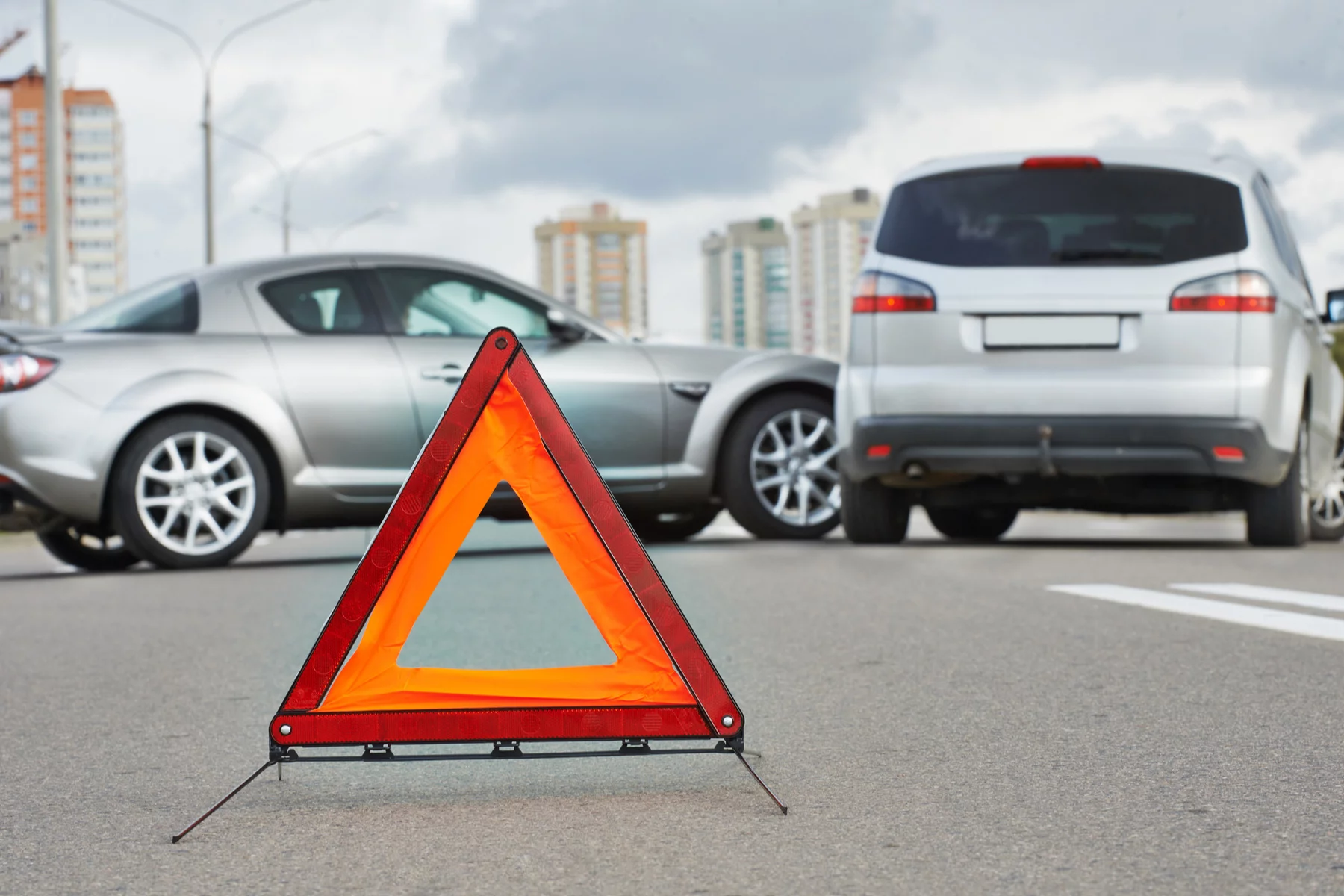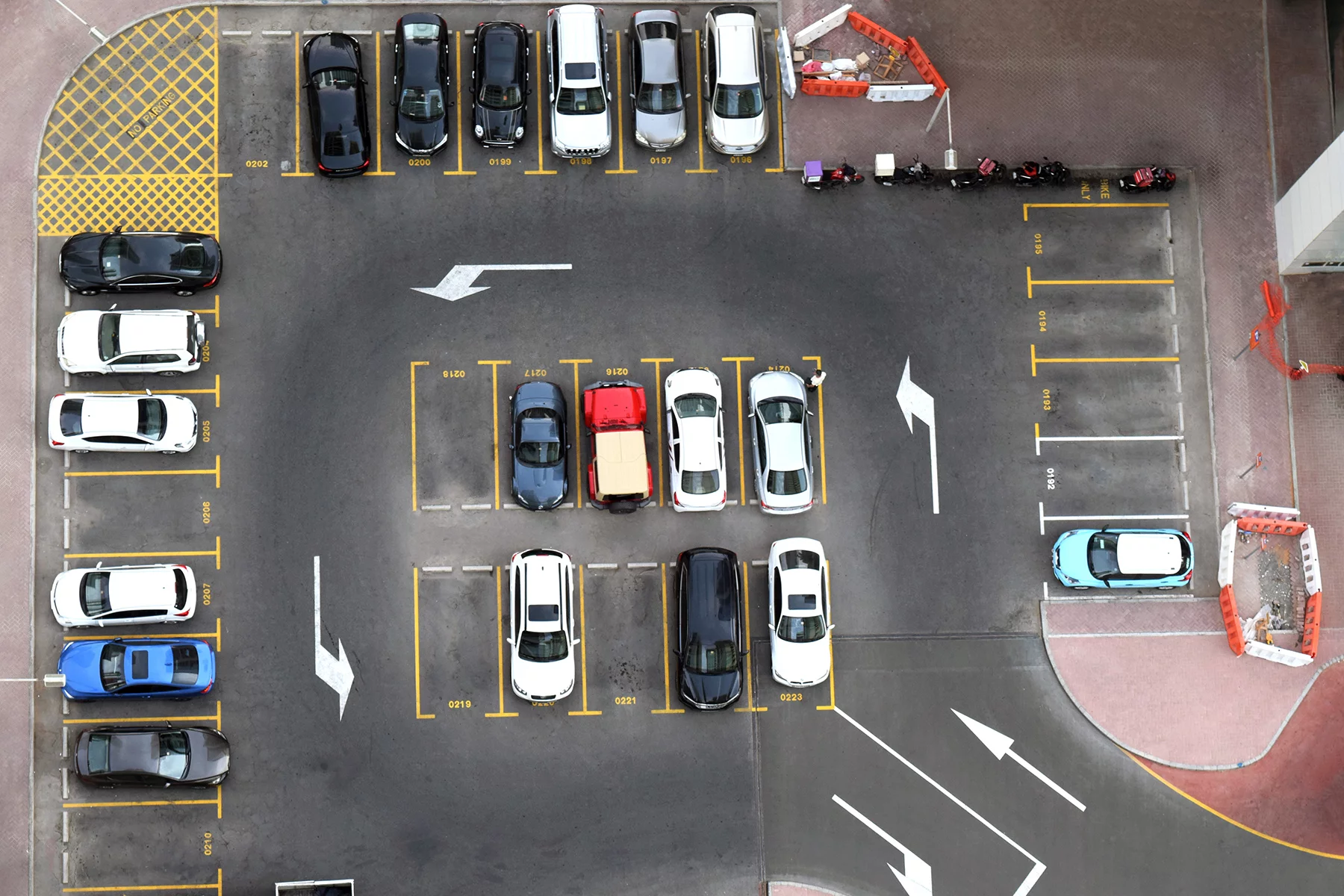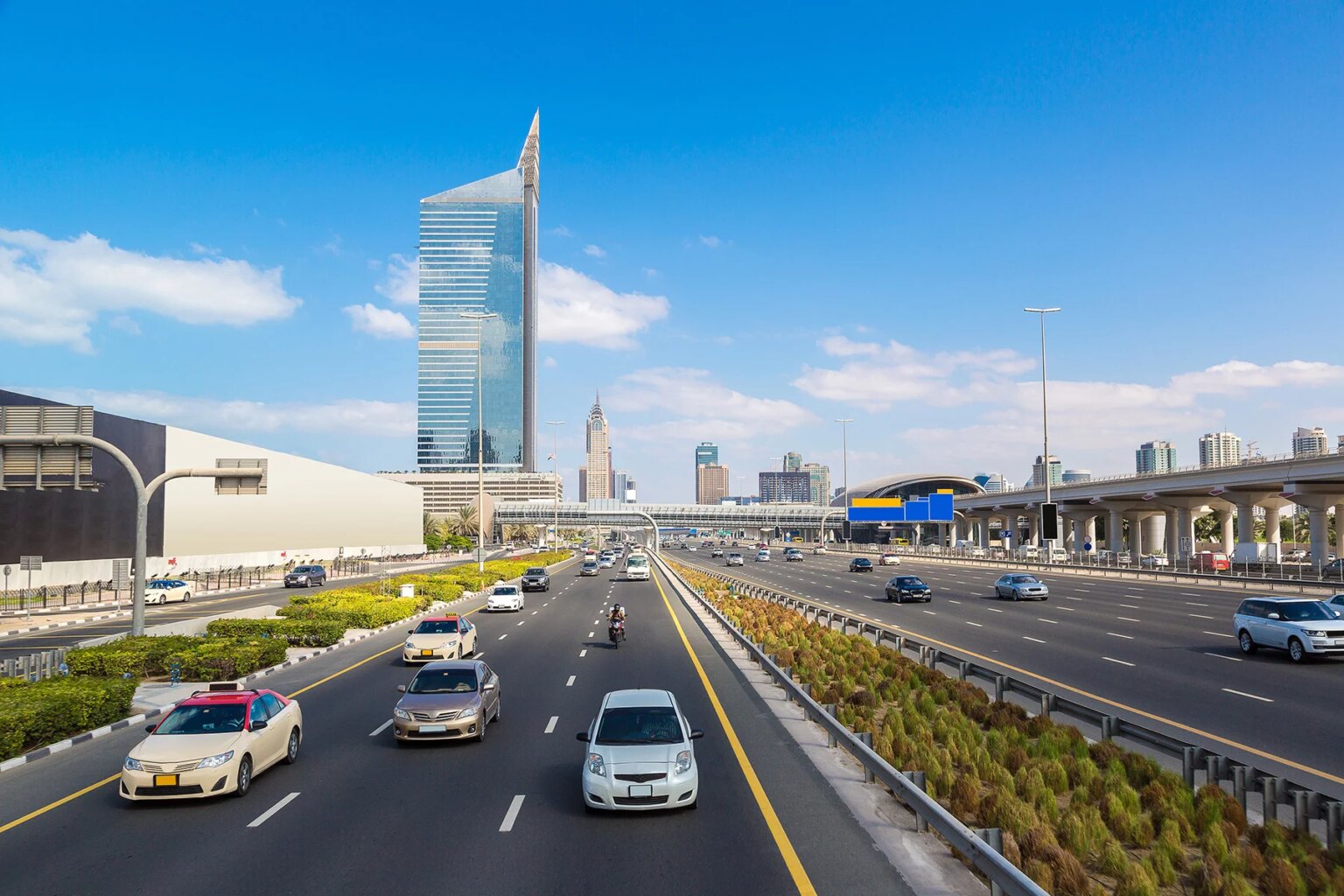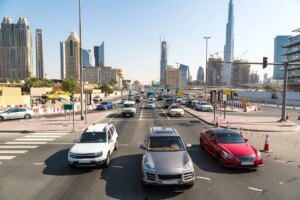This article includes the following:
- Driving in the United Arab Emirates
- Who can drive in the UAE?
- Drivers with disabilities
- Car registration and maintenance
- Cost of driving in the UAE
- Driving rules and penalties
- Traffic information in the UAE
- Parking in the UAE
- Road accidents and breakdowns
- Cars in the UAE
- Car repairs
- Tips on driving in the UAE
- Useful resources
Driving in the United Arab Emirates
Driving in the UAE is on the right (i.e., the driver sits on the left of the car). On a dual-carriageway, you’ll be driving on the right side.
The road system is modern and new, the style fast and confident, sometimes overly confident, bordering on the aggressive. You will encounter fast city driving, or if it’s rush hour, a complete standstill. In residential areas, you might well be slowed down by a few goats or chickens, while outside the cities, it’s desert conditions with sand dunes and/or camels on the roads providing the daily challenges.
The good news is, fuel is cheap.

You will find that pretty much everybody has a car – or at least a driver. Even though public transport is available, quite simply, the only way to get from A to B is by car, unless you live and work right in the heart of the cities. Statistics from the Roads and Transport Authority (RTA) suggest that there are 540 cars per 1,000 people in the UAE.
The RTA oversees the roads, vehicles, and public transport across the UAE. Its website gives the entire lowdown on transportation in the UAE.
Who can drive in the UAE?
The minimum driving age in the UAE is 18 years, and 21 years for renting a car. Tourists may hire and drive a car with either:
- their national permit, depending on the country of origin
- and/or with an International Driving License, for as long as their visas last
Driving in the UAE for expats
Internationals must immediately obtain a temporary driving license of their emirate. They can then either exchange their national license for a local one or start the procedure of obtaining a local license.
Licenses of countries that are eligible to transfer their documents include Gulf states, European Union (EU) member states, Australia, Canada, Japan, South Korea, New Zealand, South Africa, Switzerland, Türkiye, the United Kingdom, and the US.
To transfer the documents, you will need to bring the following documents to the local RTA branch:
- your original driving license with a translation into Arabic
- a no-objection certificate from your employer
- a recent eye test, your UAE ID card
- your residence visa
- passport photos
After an hour or so, you will be able to pick up your local license. Each emirate has slightly different procedures. In Dubai, the transfer costs AED 410.
If your license has not been issued in one of the above countries, the procedure is somewhat more complicated. You will have to undergo lessons and tests and basically start anew.

Once you have your new driving license from whichever emirate’s RTA, you will be able to drive throughout the UAE and the various GCC states. The licenses are credit-card sized and show your photo, full name, nationality, and valid from-to dates, plus the vehicle class you are permitted to drive. The duration of your license depends on your original license and length of residence permit but can be easily renewed.
Drivers with disabilities
Please note that the UAE refers to people with special needs or disabilities as people of determination, so if you are searching for information, use that term for easier success.
Drivers with a disability can drive in the UAE, as long as they held a driving license before. If not, they can undergo special driving lessons to obtain a local license.
There are several dealers that specialize in cars suitable for various disabilities. Drivers can register for a pass that allows free access through the SALIK toll gates, preferred parking, and free public transport.
For more information, please see the details on the RTA website.
Car registration and maintenance
If you are thinking of importing your car into the UAE, you will first of all have to have:
- a residence permit
- a vehicle clearance certificate
If the car is a right-hand drive and/or older than 10 years, you will need to check with the RTA to see if you will be allowed to bring it in. Once it has arrived you will need to register the car with the RTA.
If you are buying a new car, you will be exempt from registration for the first two years, as your dealer will take care of the paperwork for you. If you are buying second-hand, then you will need to change ownership, again with the RTA.
Renewing your car registration in the UAE
Once a year, you need to renew your registration. RTA officials will check your car for roadworthiness. Everything from tires to chassis, braking, steering, and suspension will be inspected. The testing is done on-site, while you queue with your ID, driving license, old registration, insurance document, and eventually said roadworthy certificate. You need to pay all your driving fines up to date before you can re-register. The cost of the test is around AED 200 and the registration is AED 350. If your car fails its test, you have 30 days to take it to a service station to get it repaired and retested.
Cost of driving in the UAE
Obviously, maintenance and driving costs depend very much on the type of car you are driving. Estimated costs for a medium-sized car (e.g., a Toyota Corolla) are around AED 18,000.
- Maintenance – the annual registration and safety test is around AED 550;
- Taxes – if you are importing your car, there is a 5% import tax, plus insurance, plus shipping charges;
- Insurance – for said Toyota Corolla, comprehensive insurance costs around AED 3,000 to 4,000 per year;
- Road Tolls – The road toll system called SALIK charges you AED 4 each time you pass through a gate. You will need a tag, purchasable at the RTA, inside your windscreen to automatically pay. There is no daily maximum limit, so the amount you pay each day will depend on how many times you go through a gate;
- From mid-October 2019, there is a new toll road between Dubai and Abu Dhabi. Any registered drivers outside Abu Dhabi will need to register with the Department of Transport. An initial fee of AED 100 is applied, and after that, the toll will be AED 2 off-peak and AED 4 peak;
- Fuel Costs – Super 98 is charged at AED 2.28 per liter, Special 95 at AED 2.16, E-Plus 91 AED 2.08, Diesel AED 2.38 per liter
Driving rules and penalties
General rules of driving in the UAE include obvious laws such as:
- only use hands-free phones
- use your seatbelt
- place your children in suitable child seats in the back of the car
As driving is on the right, you overtake on the left-hand side. That said, many large roads in the UAE are freeways, so you can overtake on either side.
You must keep in your car:
- your insurance documents
- a warning triangle
- a spare wheel
- a fire extinguisher
You must also have your driving license, car registration, and ID on you.
One of the most important rules you should know is that there is zero tolerance towards alcohol in the UAE while operating a vehicle. Not even a cognac-infused chocolate or one small sip is allowed. If caught, you can expect one month to three years in jail, and a fine of AED 20,000 to 30,000.
Speed limits are:
- 100–160 km/h on highways;
- 100 km/h in rural areas;
- 40–80 km/h in urban areas;
- 40 km/h in residential areas;
- 25 km/h in parking areas and on service roads
Exceeding the speed limit will cost you between AED 300 to 3,000, depending on how much you are pushing it. If you are exceeding the limit by more than 60 km/h, you will also be subject to black points on your license. The maximum number of points you can have on your license is 24 points. If you exceed this, you will lose your license for one year.
Being caught drunk driving will get you 24 points immediately. Exceeding the speed limit by more than 80 km/h will get you 23 points. Running a red light will get you eight. Each point is valid for one year. Driving without a license results in a jail term, and a hefty fine.
Road signs in the UAE
The road signs in the UAE are both in English and Arabic and are modeled on the British system. Mostly, if you have a driving license, they are self-explanatory.
Traffic information in the UAE
The UAE has a modern road system, but a lot of cars. So, during rush hour it just gets worse. There are hotspots, such as Sheikh Zayed Road and Al Barsha in Dubai, Salam Street in Abu Dhabi, and the road between Dubai and Sharjah, to name a few. If you can, avoid school dropping off and picking up times. Also, check for road works in your emirate. The following apps help you stay up to date in real-time:
- Here We Go – directions and public transport comparisons
- Waze – tells you of speed traps
- UAE Traffic – traffic updates
Also keep the radio on, as they regularly update you on traffic conditions.
Parking in the UAE
The good thing about the big cities in the UAE being relatively young cities is that most buildings provide parking, be it residential, business, malls, or metro stations. Parking spaces and costs differ between emirates and facilities but are generally free on Fridays and holidays such as Eid. Otherwise, parking can be paid for at meters, via apps or texts, or pre-paid cards.
Prices in non-commercial areas are roughly AED 2 for one hour of parking, AED 4 for two hours, AED 8 for three hours. Pre-paid cards are available in AED 30, 50, and 100 increments.
Fines for illegal parking range from AED 200 to AED 1,000, and can be paid at the RTA branch in your emirate.
Road accidents and breakdowns
The statistics released in March 2019 were dire for the UAE: two people have died on the UAE’s road every day in the last five years, with the majority of accident victims aged between 18 and 30. The good news is that the rates are falling, albeit slowly, as laws are becoming more stringent.
Accidents
If you are in an accident, move the car into a safe place, preferably not obstructing traffic, put your hazard lights on and the warning triangle up, and call 999. If there are injuries, please ask for an ambulance before asking for the police. Wait for the police to arrive and have your insurance papers, car registration, driving license, and ID ready. Take a photo of the incident and the damage. Should the other party drive off, try and make note of their car’s number plate.

Follow the instructions of the police, and remain calm. Getting upset or worse, angry, will make the situation worse. The police will complete a report and hand out various copies: pink to the driver at fault, green to the innocent party, or white if it was neither person’s fault. The police will tell you the next steps. After, call your insurance company and either wait for the replacement car or drive home and deal with the damage once the insurance gives the all-clear.
Vehicle breakdowns
If your car breaks down, try and come to a standstill away from the traffic. Put your hazard lights on and put the warning triangle up. If you cannot repair the fault yourself, call your chosen roadside assistance company, your automobile association, your dealer, or your usual garage. Keep the number handy in your car at all times.
Cars in the UAE
Despite the roads seemingly teeming with large SUVs and luxury sports cars, the most commonly insured car is, according to statistics, the humble Toyota Corolla. The most common color is white, to deflect the blistering Emirati heat. It does make sense to have a large, reliable car or an SUV, especially when you have a family – and even more so if you want to explore the nearby desert and want to drive off-road.
Each emirate has its own version of number plates. Generally, you are given one by the RTA, in number order. But you can also spend a small fortune on personalized vanity plates, in regular auctions.
Importing a car to the UAE
You can import cars that are left-hand drive, although sometimes exceptions are made for classic models. The car should be younger than 10 years old. If yours is older, please check with the RTA first. You will need to have:
- your residency
- UAE driving license
- the original invoice of the car
- certificate of origin
- shipping receipt
- customs fees of around 5% of the value of the car
A customs clearance certificate will be issued at the port, for a fee of around AED 5,000, plus AED 500 for container inspection. After receipt of your car, you will have to register it at the RTA.
Buying a car in the UAE
Buying a new car in a country where car ownership is practically a must, is very easy.

Once you made your choice of vehicle and dealership, you can choose from various payment and finance options, and the dealer will sort out the registration and insurance for you. Buying a used car is equally straightforward, only that you will need to take the car straight to the RTA to register it and change ownership.
Renting a car in the UAE
The UAE has all the known rental car companies, and then some. Most companies are represented in the airports, and as long as you are 21 years old and above and have held a driving license for at least one year, you can rent a car short term.
You can drive on licenses from EU countries, Gulf states, and Australia, Canada, New Zealand, South Africa, and the United States. Licenses from any other country require an International Driving Permit.
This only applies to short-term visitors. Once you have a residence permit, you will need to get a local license. Depending on the type of car, you can pay between AED 50 to AED 500 per day.
Selling a car in the UAE
Before selling your car, you will need to make sure all outstanding finance and fines are cleared. If you are going through a trader to sell your car for you, it’s easy, you will have less hassle, but also need to pay a commission or expect a lower value. If you are going it alone, place an advert in something like Dubizzle, for a fee of AED 200. Do not put a notice in your car, it is illegal, even if you will see people do it everywhere.
Get your car inspected and signed off as road-worthy by the RTA who will issue an AED 120 30-day certificate, before you see any potential buyers, as this will make it easier.
Once you have a buyer, have completed the test drive, and agreed on a price, the ownership will need to be transferred to the buyer at the RTA.
Carpooling/car sharing in the UAE
One official carpooling site has recently been suspended following abuse, but there are still some around, such as Darb in Abu Dhabi. The official line is that it is illegal to organize it through the sites. That said, it is common enough for people living in the same compound or apartment block to share rides for school drop-off or pick-up. Equally, people share rides to work if convenient. Just organize it privately.
Car repairs
Driving being a major pastime in the UAE, there are car repair services everywhere, especially around the Al Quoz area. If you have bought your car locally, you will have an address for a reputable service specific to your car. If you want to go cheaper, you can find many small repair places in industrial areas. But beware of fake tires and spare parts, as this is a thriving trade.
Tips on driving in the UAE
- Remember the zero tolerance on drunk driving at all times
- Refrain from swearing and hand signals at all times
- Drive confidently, and don’t be surprised if you find a camel on the road, a lawn-mover driving toward you on the wrong side, or people reversing in a roundabout. It is all part of the challenge.
- Be aware that during Ramadan, at Iftar time, people drive extremely fast to get home and eat, so best avoid driving for a little while.
- Rubbernecking is a problem on the roads. While it is illegal, it still causes huge delays around accidents. Don’t do it.




